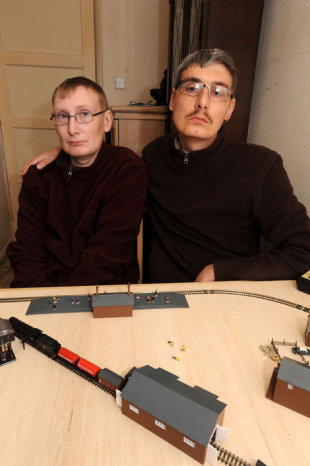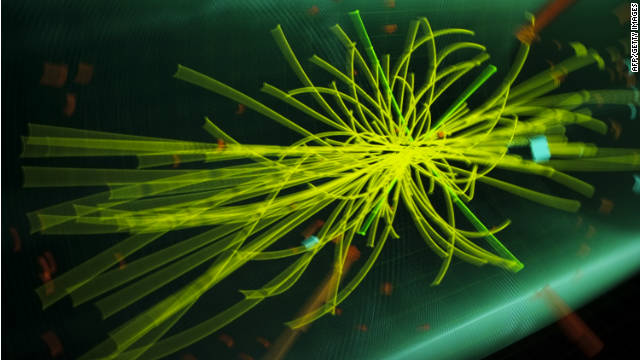What is the Higgs boson and why is it important?
By Nick Thompson, CNN
July 4, 2012 -- Updated 0727 GMT (1527 HKT)
STORY HIGHLIGHTS
- Scientists say they've found new evidence the Higgs boson exists
- The so-called "God particle" is thought to be a building block of the universe
- The theoretical particle is key to understanding how universe works, experts say
(CNN) -- Scientists say they are closer to
proving the existence of the Higgs boson -- a never-before-seen subatomic particle long thought to be a fundamental building block of the universe.
Researchers at the
Large Hadron Collider
under the Alps are unveiling their latest results on the so-called "God
particle" at an eagerly awaited seminar at the CERN particle physics
laboratory in Geneva, Switzerland.
Experts say finding the elusive particle would rank as one of the top scientific achievements of the past 50 years.
What is the Higgs boson?
The Standard Model of
particle physics lays out the basics of how elementary particles and
forces interact in the universe. But the theory crucially fails to
explain how particles actually get their mass.
Particles, or bits of
matter, range in size and can be larger or smaller than atoms.
Electrons, protons and neutrons, for instance, are the subatomic
particles that make up an atom.
Scientists believe that the Higgs boson is the particle that gives all matter its mass.
Experts know that
elementary particles like quarks and electrons are the foundation upon
which all matter in the universe is built. They believe the elusive
Higgs boson gives the particles mass and fills in one of the key holes
in modern physics.
Higgs boson is the last missing piece of our current understanding of the most fundamental nature of the universe.
Physicist Martin Archer
How does the Higgs boson work?
The Higgs boson is part
of a theory first proposed by physicist Peter Higgs and others in the
1960s to explain how particles obtain mass.
The theory proposes that
a so-called Higgs energy field exists everywhere in the universe. As
particles zoom around in this field, they interact with and attract
Higgs bosons, which cluster around the particles in varying numbers.
Imagine the universe
like a party. Relatively unknown guests at the party can pass quickly
through the room unnoticed; more popular guests will attract groups of
people (the Higgs bosons) who will then slow their movement through the
room.
The speed of particles
moving through the Higgs field works much in the same way. Certain
particles will attract larger clusters of Higgs bosons -- and the more
Higgs bosons a particle attracts, the greater its mass will be.
Why is finding the Higgs boson so important?
While finding the Higgs
boson won't tell us everything we need to know about how the universe
works, it will fill in a huge hole in the Standard Model that has
existed for more than 50 years, according to experts.
"The Higgs boson is the
last missing piece of our current understanding of the most fundamental
nature of the universe," Martin Archer, a physicist at Imperial College
in London, told CNN.
"Only now with the LHC
[Large Hadron Collider] are we able to really tick that box off and say
'This is how the universe works, or at least we think it does'."
"It's not the be all and
end all -- but in terms of what can we say practically about the world
and how the world is, it actually tells us a lot."
Gordon Kane, director of
the Michigan Center for Theoretical Physics, added that finding
evidence of the Higgs boson would be a "very wonderful success of
science and of people for four centuries."
Why is the Higgs boson called the "God particle?"
The popular nickname for
the elusive particle was created for the title of a book by Nobel Prize
winning physicist Leon Lederman -- reportedly against his will, as
Lederman has said he wanted to call it the "Goddamn Particle" because "
nobody could find the thing."
"'God particle' is a
nickname I don't really like," says Archer. "It's nothing to do with
religion -- the only (theoretical) similarity is you're seeing something
that's a field that's everywhere, in all spaces."
How are scientists searching for the Higgs boson?
For the past eighteen
months scientists have searched for the Higgs boson by smashing protons
together at high energy in the $10 billion Large Hadron Collider (LHC)
at CERN in Geneva, Switzerland.
If we don't see [Higgs], it means the universe is more complicated than we thought.
Physicist Martin Archer
Inside the LHC, which is
located 328 feet underground in a 17-mile tunnel and is the most
powerful particle accelerator ever built, high speed proton collisions
generate a range of even smaller particles that scientists sift through
in search of a signal in the data suggesting the existence of the Higgs
boson.
"You're just hoping that somewhere in these collisions that you see something ... some sort of a statistical bump," says Archer.
If Higgs bosons exist,
they are elusive, popping up and then disappearing again quickly. It
means, says Archer, that scientists at the LHC will only be able to
observe their decaying remnants.
It has taken years for
scientists to narrow down the range of mass in which they believed the
Higgs boson could exist -- but during the past year a statistical bump
suggests they're on the right track.
"Now they're starting to get a bump, the scientists should be able to get that result more and more," says Archer.
What if scientists don't find the Higgs boson?
The general consensus among physics academics is that the Higgs field and boson exists, according to Archer.
"It just makes sense
within the framework that we've got everything set up in, given that
everything else that we can describe and we can see seems to be
described in this simple way," says Archer.
Nearly every scientist
believes that the Large Hadron Collider will either prove or disprove
the existence of the Higgs boson once and for all -- so if the LHC
doesn't find it, it doesn't exist, experts say.
Martin Archer believes a failure to find the Higgs boson would be even more exciting than discovering the elusive particle.
"If we don't see it, it
actually means that the universe at the most fundamental level is more
complicated than we thought," says Archer, "and therefore maybe the way
we've been attacking physics isn't right."
 By the looks of their home, Tony and Christine Clark are raising two
rambunctious 7-year-old boys. Model train tracks and Monopoly pieces are
scattered on tables and cartoons flicker on the TV set.
By the looks of their home, Tony and Christine Clark are raising two
rambunctious 7-year-old boys. Model train tracks and Monopoly pieces are
scattered on tables and cartoons flicker on the TV set.















